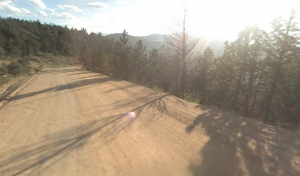For our honeymoon we cruised on Carnival Imagination for four days to Cozumel. This is part of a series of anecdotes on the experience.
On our last day aboard, Carnival offered a “Behind the Fun” tour visiting all the crew-only areas of the ship to show how the magic is made. I couldn’t resist! The answer: it’s made through a lot of hard work.
We visited the galley, where a bar of baking chocolate as large as a desk literally and figuratively dwarfed everything else in the room. I ate some of it in the form of cake at the all-you-can-eat chocolate buffet later that day.
We visited the laundry room, where workers fed sheets into giant machines to be folded and ironed, in an endless progression. We tourists got to try our hand at the towel folding machine. As we giggled with goofy delight at seeing an unfolded towel enter, and then drop seconds later into a neatly folded pile, the crewmen’s eyes seemed to say, “You realize we get paid to do this all day, right?”
We visited the bridge, where one officer must always be looking out to sea, while others supervise an array of modern cartographic technology.
We visited the engine control room, where one whole wall schematically depicts the flow of electricity to various ship systems, with an enormous console filled with gauges and buttons and levers stood ready to run the entire ship if needed.
But surprisingly, the visit that’s stuck with me most was the ship’s stores: giant freezers stocked with meat, poultry, and seafood; a refrigerator the size of a large bedroom full of liquor and other beverages; and workrooms to prepare food for the galley. (For whatever reason, chopping vegetables and meats isn’t charged to the galley staff, but to the provisioning department.)
On opposite sides of the ship mirror freezers, thawing refrigerators, and prep tables process separately the poultry and meat headed up to the galley. Carnival has one supervisor for meat and another for poultry to ensure that no one person ever handles both.
In one room, a pair of crewmen cut fruits and vegetables, with boxes of carrots and cantaloupes piled around them and a work counter covered in bowls of freshly chopped ingredients.
And in one room — in the most staggering room — were potatoes. Boxes of potatoes piled high along every wall, with a diminutive machine in one corner to peel them, and a small work table in the center. They called the worker there Potato Man, and his only job is to cut potatoes.
Like all crewmen we met, he works ten hour shifts. Like all crewmen we met, he works seven days a week. And like all crewmen we met, he has a six month contract, and then two months off before the next contract.
So for ten hours a day, seven days a week, six months at a time, he cuts potatoes. He does not trade jobs, since Potato Man is his assigned position. He does not get to try his hand at chopping the occasional cucumber or celery stalk. He just stands at his post, reducing potatoes to edible sizes.
And when his boss introduced him to us as Potato Man, an unmistakably authentic grin spread across his face, and he gave us an enthusiastic thumbs up. He is the Potato Man on that ship, and he knows it.
Most of the crewmen we met had been working those long hours and weeks for decades with the company. And we tourists were there to get respite from a few months of grueling nine-to-five computer work.
They served hash browns at breakfast the next morning, and oh were they delicious.


